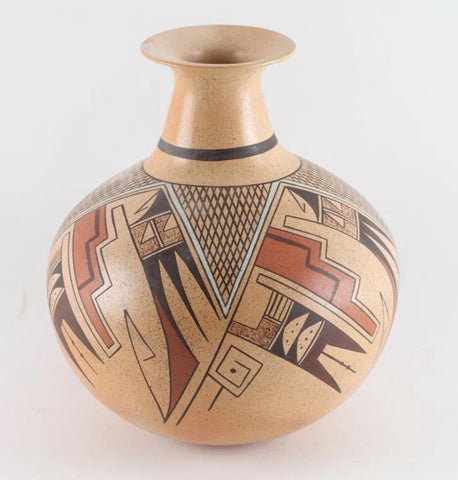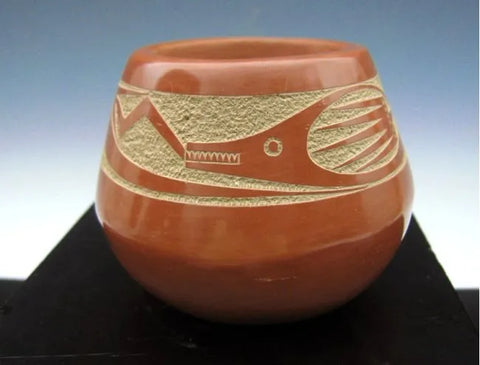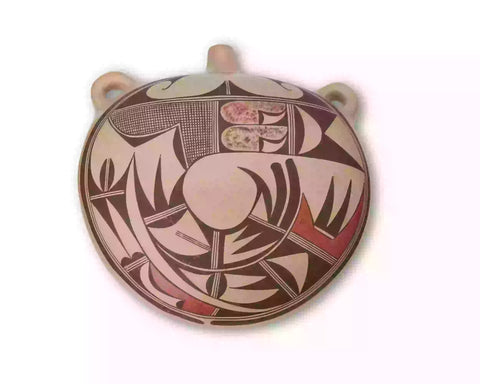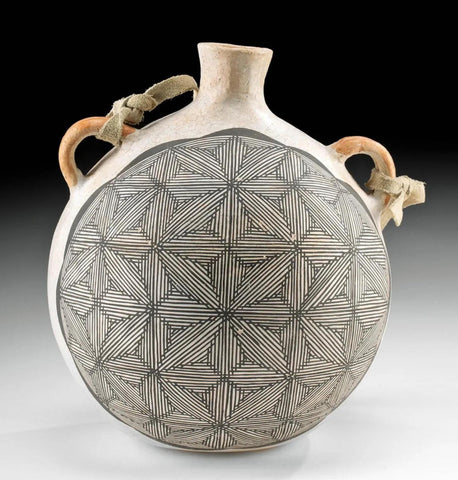
Native American Santo Domingo Pottery Bowl, by Paulita Pacheco, Ca 1980's, #1183
$ 1,600.00
Native American
Santo Domingo Pottery Bowl, by Paulita Pacheco, Ca 1980's, #1183
Discription: #1183 Native American Santo Domingo Pottery Bowl, by Paulita Pacheco, Ca 1980's,
Dimenstions: 8" x 11"
Condition: Excellent for its age
Paulita Pacheco is a member of the Fire Clan, born in 1943, and Gilbert is a member of the Corn Clan. Continuing traditional ways of life is very important to these fine artisans. Paulita was inspired to learn the art of working with clay from the late Juanita C. Tenorio (mother) and the late Andrea Ortiz (grandmother). At the age of 12, Paulita assisted her elders with gathering natural pigments from the grounds within the Santo Domingo Pueblo. Eventually, she was taught how to hand coil and paint on pottery. She was also inspired by her brother, Robert Tenorio. Gilbert also learned the art of working with clay at a very young age. He too assisted his elders with their pottery. (Source Historic Cameron Trading Post)
Paulita and Gilbert specialize in hand coiled traditional Santo Domingo pottery. They continue using the pottery making methods of their ancient ancestors. This pair of fine artisans contribute equally with the process of making their fine art. They hand coil many shapes and sizes of quality pottery. Paulita and Gilbert are proud of continuing a long lived tradition and hope the younger members of their Pueblo become inspired by them. They sign their pottery: Paulita Pacheco and a corn symbol to denote Gilbert’s clan. They are related to the famous Hilda and late Arthur Coriz (sister and brother-in-law).
“Pueblo pottery is made using a coiled technique that came into northern Arizona and New Mexico from the south, some 1500 years ago. In the four-corners region of the US, nineteen pueblos and villages have historically produced pottery. Although each of these pueblos use similar traditional methods of coiling, shaping, finishing and firing, the pottery from each is distinctive. Various clays gathered from each pueblo’s local sources produce pottery colors that range from buff to earthy yellows, oranges, and reds, as well as black. Fired pots are sometimes left plain and other times decorated—most frequently with paint and occasionally with appliqué. Painted designs vary from pueblo to pueblo, yet share an ancient iconography based on abstract representations of clouds, rain, feathers, birds, plants, animals and other natural world features.
Tempering materials and paints, also from natural sources, contribute further to the distinctiveness of each pueblo’s pottery. Some paints are derived from plants, others from minerals. Before firing, potters in some pueblos apply a light colored slip to their pottery, which creates a bright background for painted designs or simply a lighter color plain ware vessel. Designs are painted on before firing, traditionally with a brush fashioned from yucca fiber.
Different combinations of paint color, clay color, and slips are characteristic of different pueblos. Among them are black on cream, black on buff, black on red, dark brown and dark red on white (as found in Zuni pottery), matte red on red, and polychrome—a number of natural colors on one vessel (most typically associated with Hopi). Pueblo potters also produce undecorated polished black ware, black on black ware, and carved red and carved black wares.
Making pueblo pottery is a time-consuming effort that includes gathering and preparing the clay, building and shaping the coiled pot, gathering plants to make the colored dyes, constructing yucca brushes, and, often, making a clay slip. While some Pueblo artists fire in kilns, most still fire in the traditional way in an outside fire pit, covering their vessels with large potsherds and dried sheep dung. Pottery is left to bake for many hours, producing a high-fired result.
Today, Pueblo potters continue to honor this centuries-old tradition of hand-coiled pottery production, yet value the need for contemporary artistic expression as well. They continue to improve their style, methods and designs, often combining traditional and contemporary techniques to create striking new works of art.” (Source: Museum of Northern Arizona)
Santo Domingo Pottery Bowl, by Paulita Pacheco, Ca 1980's, #1183
Discription: #1183 Native American Santo Domingo Pottery Bowl, by Paulita Pacheco, Ca 1980's,
Dimenstions: 8" x 11"
Condition: Excellent for its age
Paulita Pacheco is a member of the Fire Clan, born in 1943, and Gilbert is a member of the Corn Clan. Continuing traditional ways of life is very important to these fine artisans. Paulita was inspired to learn the art of working with clay from the late Juanita C. Tenorio (mother) and the late Andrea Ortiz (grandmother). At the age of 12, Paulita assisted her elders with gathering natural pigments from the grounds within the Santo Domingo Pueblo. Eventually, she was taught how to hand coil and paint on pottery. She was also inspired by her brother, Robert Tenorio. Gilbert also learned the art of working with clay at a very young age. He too assisted his elders with their pottery. (Source Historic Cameron Trading Post)
Paulita and Gilbert specialize in hand coiled traditional Santo Domingo pottery. They continue using the pottery making methods of their ancient ancestors. This pair of fine artisans contribute equally with the process of making their fine art. They hand coil many shapes and sizes of quality pottery. Paulita and Gilbert are proud of continuing a long lived tradition and hope the younger members of their Pueblo become inspired by them. They sign their pottery: Paulita Pacheco and a corn symbol to denote Gilbert’s clan. They are related to the famous Hilda and late Arthur Coriz (sister and brother-in-law).
“Pueblo pottery is made using a coiled technique that came into northern Arizona and New Mexico from the south, some 1500 years ago. In the four-corners region of the US, nineteen pueblos and villages have historically produced pottery. Although each of these pueblos use similar traditional methods of coiling, shaping, finishing and firing, the pottery from each is distinctive. Various clays gathered from each pueblo’s local sources produce pottery colors that range from buff to earthy yellows, oranges, and reds, as well as black. Fired pots are sometimes left plain and other times decorated—most frequently with paint and occasionally with appliqué. Painted designs vary from pueblo to pueblo, yet share an ancient iconography based on abstract representations of clouds, rain, feathers, birds, plants, animals and other natural world features.
Tempering materials and paints, also from natural sources, contribute further to the distinctiveness of each pueblo’s pottery. Some paints are derived from plants, others from minerals. Before firing, potters in some pueblos apply a light colored slip to their pottery, which creates a bright background for painted designs or simply a lighter color plain ware vessel. Designs are painted on before firing, traditionally with a brush fashioned from yucca fiber.
Different combinations of paint color, clay color, and slips are characteristic of different pueblos. Among them are black on cream, black on buff, black on red, dark brown and dark red on white (as found in Zuni pottery), matte red on red, and polychrome—a number of natural colors on one vessel (most typically associated with Hopi). Pueblo potters also produce undecorated polished black ware, black on black ware, and carved red and carved black wares.
Making pueblo pottery is a time-consuming effort that includes gathering and preparing the clay, building and shaping the coiled pot, gathering plants to make the colored dyes, constructing yucca brushes, and, often, making a clay slip. While some Pueblo artists fire in kilns, most still fire in the traditional way in an outside fire pit, covering their vessels with large potsherds and dried sheep dung. Pottery is left to bake for many hours, producing a high-fired result.
Today, Pueblo potters continue to honor this centuries-old tradition of hand-coiled pottery production, yet value the need for contemporary artistic expression as well. They continue to improve their style, methods and designs, often combining traditional and contemporary techniques to create striking new works of art.” (Source: Museum of Northern Arizona)
Related Products
Sold out
Sold out









